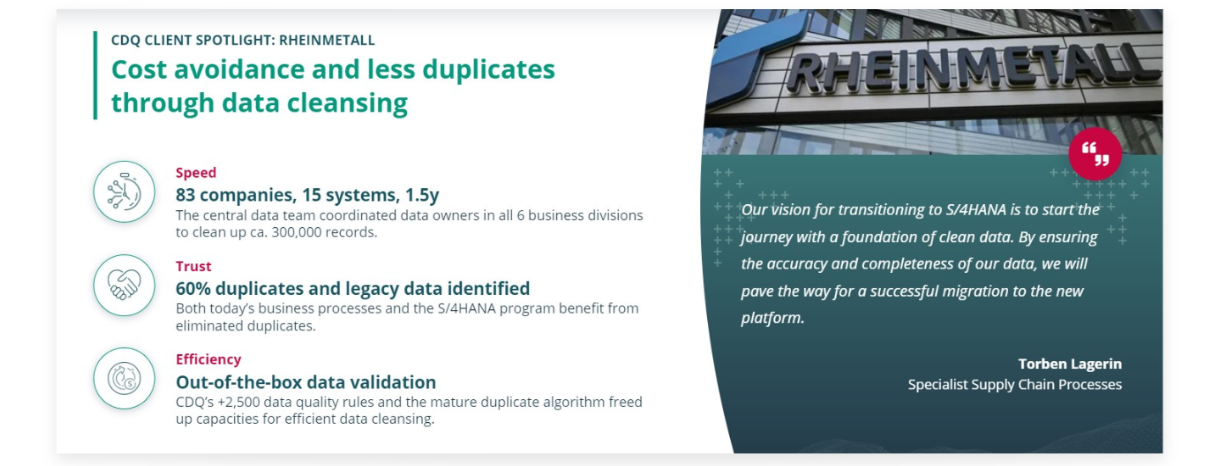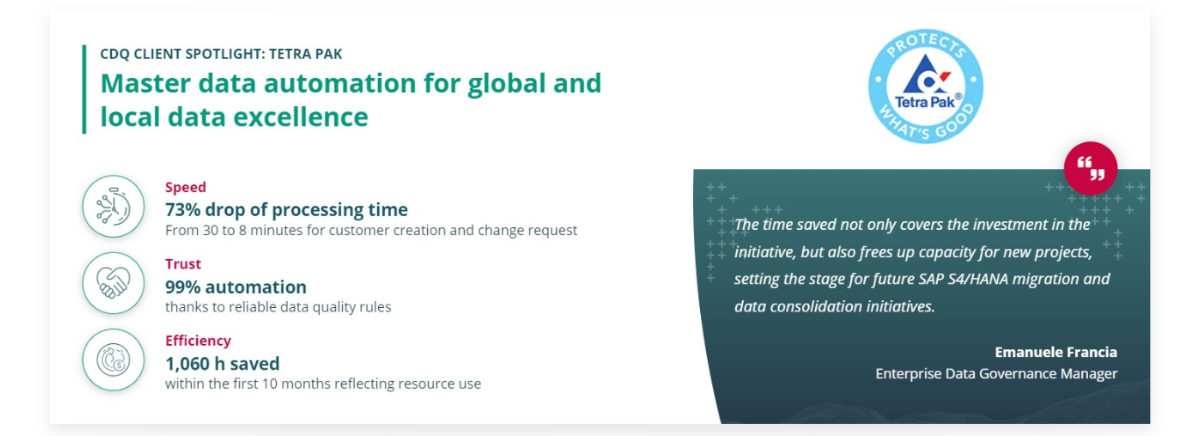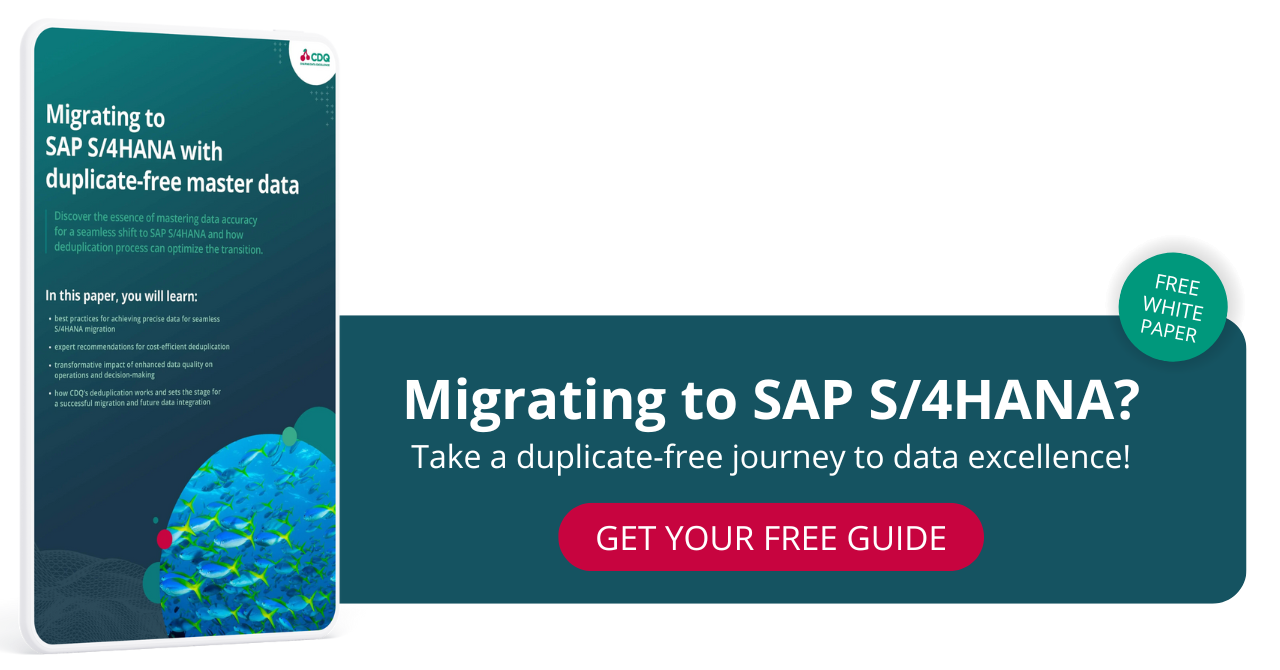On the way to SAP S/4HANA: migration scenarios supported by Data Quality

Transitioning to SAP S/4HANA is a significant step for any organization looking to modernize its enterprise resource planning (ERP) system. This transition can be challenging, but it also offers a host of benefits, such as improved efficiency, better decision-making, and enhanced competitiveness.
However, one of the key challenges during the transition is ensuring data quality, especially for critical areas like business partner master data. In this article, we will explore three typical transition scenarios for SAP S/4HANA and how CDQ can help in each of them.
The role of Data Quality
Before diving into transition scenarios, let's give data quality a shoutout. To fully leverage the benefits of SAP S/4HANA, it is critical to improve the quality of business partner master data. The shocking truth is that countless companies are pouring millions of Euros and often dedicating as much as five years to S/4HANA migrations. But here's the catch: if your data isn't prepared for the transformation, you might as well be burning your money!
On average, 16% of business partner records in any organization are unintended duplicates. Considering process costs, data acquisition expenses, and the impact on strategy decisions we have estimated, together with the CDQ Data Sharing Community member companies, that the cost of a single duplicate can be as much as 1,000 Euro!
You expect SAP S/4HANA to be lightning-fast compared to R/3, but speed without precision is simply fast in the wrong direction navigating through cumbersome SAP transactions, extracting reports, downloading them, and then grappling with data errors that demand extensive adjustments before presenting to the CFO. With S/4HANA, this process is seamlessly integrated – essential numbers are instantly available, and the CFO can access real-time insights via the intuitive Fiori dashboard. However, even with these advancements, the reliability of reports hinges crucially on the cleanliness of underlying data. Without addressing issues like duplicates, the transformative potential of SAP S/4HANA remains unrealized.
Centralization of IT systems
Many enterprises are moving towards centralized IT ecosystems, seeking to consolidate disparate systems like CRM, ERP, WMS, and TMS into cohesive frameworks. This consolidation aims to streamline operations and harmonize data management practices across various business units and geographical locations. As organizations prepare for SAP S/4HANA migration, the challenge lies in aggregating data from numerous sources into unified datasets that adhere to standardized formats and quality benchmarks. To streamline operations, data from hundreds of systems needs to be consolidated into a few dozen.
Enhancing Data Quality for the migration
CDQ solutions are pivotal in optimizing data quality throughout SAP S/4HANA migration projects. By leveraging CDQ's capabilities, organizations can address familiar challenges such as:
Data Deduplication: Identifying and resolving duplicate records across disparate systems is a daunting task without automated solutions. CDQ's data quality rules and integration capabilities streamline this process, ensuring that business partner data remains consistent and accurate.
Standardization and Cleansing: The transition to SAP S/4HANA necessitates cleansing and standardizing legacy data to align with SAP's One-Domain-Model (ODM). CDQ facilitates this transition by mapping existing data records to the ODM, preparing them for seamless integration into SAP S/4HANA or SAP MDG environments.
Automated Data Validation: With over 2600 data quality rules and integration with more than 70 registers, CDQ automates the validation of business partner data. This automation is critical for maintaining high data quality standards consistently across all systems and processes.

The stress curve of migration
During the migration process, organizations often encounter a "stress curve." It starts with initial discovery workshops and progressively intensifies, particularly for business users. At its zenith, the urgency of data cleansing becomes paramount, yet it frequently takes a back seat due to time pressures. This underscores two primary objectives: prioritizing data cleansing ahead of migration, a step commonly overlooked, and leveraging automation wherever possible. Proactively addressing these hurdles before transitioning to S/4HANA is essential for achieving a smooth shift with clean, reliable, and optimized data.
Three approaches to transformation
SAP differentiates three different approaches for the transformation: greenfield, system conversion, and hybrid. Each approach requires a unique strategy to improve data quality.
The greenfield approach
In a greenfield implementation, a company starts from scratch with a clean slate, setting up SAP S/4HANA without migrating legacy data. While this may seem like the least complex scenario, ensuring data quality is still crucial. All systems and processes are set up on a "green field," i.e., completely new. This presents a big opportunity to let go of old processes and legacy problems, but it also requires significant effort from stakeholders.
Process participants, busy with both their daily work and the transformation project, will try to avoid any additional work in the context of data.
Therefore, it is important to make use of predefined and ready-to-use concepts. CDQ offers several solutions in this regard:
-
Predefined Data Model
CDQ offers a data model harmonized with SAP, ready to cover 90% of all typical requirements. Many companies have used a customized data model for years or even decades. Defining a new data model takes at least months, especially given the typically missing competencies. With the ready-to-use data model, the capacity of the business participants can be focused on the remaining 10%.
-
Data Quality Rules
CDQ offers over 2600 data quality rules that serve as a solid basis to measure and improve data quality without the need to reinvent the rules. These rules are consistent with the SAP harmonized data model.
-
Data Quality Improvement
CDQ can help improve data quality without dependency on the SAP design phase. Master data records are extracted from legacy systems and uploaded to a dedicated and secured "data mirror" in the CDQ Cloud Platform. On this platform, all data quality improvements take place. Once the data is ready, it can be loaded into the new SAP system.
-
New Business Partner Onboarding
To create new business partners, a new onboarding process will be needed, typically running with SAP MDG. CDQ’s solution called Business Partner Lookup can be directly integrated into SAP MDG and can be used out of the box, making business partner onboarding a one-click exercise.
The hybrid approach
Many organizations opt for a hybrid approach, combining elements of greenfield implementation and system conversion. This scenario involves implementing S/4HANA in phases and migrating data gradually. This approach continues to use existing legacy systems while upgrading them with new S/4HANA capabilities. It requires careful planning and execution to ensure data integrity and minimize disruption to ongoing operations.
Key aspects of the CDQ-powered hybrid approach include:
- System agnostic solutions: The CDQ approach is system agnostic and can work with all systems and data models. This is crucial for organizations running multiple systems in parallel.
- Flexibility and integration: For example, a new SAP S/4HANA system may need to be established, but the transformation could take five years. During this time, an old SAP ERP system may need to run in parallel for certain business departments or locations. Existing platforms like Salesforce may also be migrated later. The data model of the cleansing tool needs to be flexible, able to map to various systems' data models, and handle complex interdependencies.
- Use of external data: A significant benefit for IT and business is the use of external data sources. CDQ has over 70 data sources already mapped, and IT only needs to implement the API to CDQ, while CDQ integrates the rest. This allows business participants to focus on critical topics.

The system conversion approach
In a system conversion, an organization upgrades its existing SAP system to S/4HANA. This scenario involves migrating data from the old system to the new one. Data quality issues may arise during this process, and this approach tries to consider many or even all concepts from the legacy systems in the new S/4HANA system. Similar challenges as in the hybrid approach apply, with an even higher demand for flexibility to cover existing data structures, processes, workflows, etc. However, this approach is less common compared to greenfield and hybrid, which are more prevalent in practice.
Typical pitfalls on your way to SAP S4/HANA
When embarking on an S/4HANA migration, organizations often encounter several common pitfalls and challenges that can hinder the successful implementation and utilization of the new system.
One of the most critical issues is the neglect of data quality during the data preparation phase. Despite the transformative promises of S/4HANA—speed, real-time insights, and user-friendliness—without meticulous attention to data quality, these benefits can quickly perish. It is common for data to be migrated hastily, with plans to clean it up post-migration. However, once the project team disperses and the initial urgency subsides, the motivation to fix data discrepancies often drops, leaving organizations with inaccurate data that undermines the very advantages S/4HANA was meant to deliver.
Another significant challenge lies in aligning business architecture with data architecture. Business users may find terms like "data model" and "data architecture" daunting or unfamiliar, leading to a disconnect between what the business needs and how data is structured to meet those needs. Defining a data architecture that truly supports business requirements takes time and deliberation—efforts that are often not sufficiently accounted for in transformation roadmaps. Questions around fundamental concepts like "business partner" and decisions on data models can arise unexpectedly, necessitating a cohesive strategy that bridges business understanding with technical implementation.
Moreover, the incentives driving project leaders and external consultants can inadvertently exacerbate these challenges. In many cases, success metrics focus narrowly on achieving a functional go-live, rather than ensuring robust data quality. This results in a rush to address only superficial data errors that could impede the loading process, rather than focusing on the substantive accuracy and relevance of the data itself. Consultants and project teams may prioritize quick fixes that do not disrupt timelines, potentially overlooking deeper data quality improvements that are vital for long-term system efficiency.
Navigating these pitfalls requires a comprehensive approach that encompasses not just technical expertise, but also strong collaboration with all stakeholders—including business leaders, project managers, and consultants. We enable organizations to successfully leverage standardized data models aligned closely with SAP standards and to streamline their migrations, demonstrating the importance of proactive planning and stakeholder engagement in achieving sustainable data quality and system performance.
Keeping the right direction
Transitioning to SAP S/4HANA is a complex but rewarding endeavor. Ensuring data quality is crucial for a successful migration, and leveraging solutions like those offered by CDQ can make a significant difference. Whether you choose the greenfield, hybrid, or system conversion approach, addressing data quality challenges head-on will help you unlock the full potential of SAP S/4HANA, resulting in a more efficient, effective, and competitive organization.
In this white paper, you will find:
- best practices for achieving precise data for seamless S/4HANA migration
- expert recommendations for cost-efficient deduplication
- insights on transformative impact of enhanced data quality on operations and decision-making
- how CDQ‘s deduplication works and sets the stage for a successful migration and future data integration
Click below and get your free copy of duplicate-free guide to SAP S/4HANA migration:

Get our e-mail!
Related blogs
Trust, automation, and the future of master data management
Master data management (MDM) is a vital, albeit often underappreciated, foundation of modern business operations. When done right, it ensures smooth processes,…
The value of automation in MDM: podcast CDQ & SAP
Automation isn’t just about efficiency - it’s about enabling growth and innovation. By automating repetitive, error-prone tasks, businesses can free up…
Efficient mass-enrichment of business partner data in SAP MDG
Managing and enriching business partner data at scale is a monumental task for many organizations, particularly during mergers, acquisitions, or large-scale…






